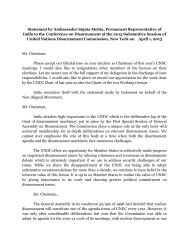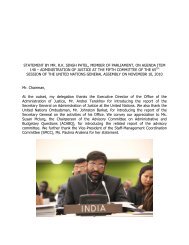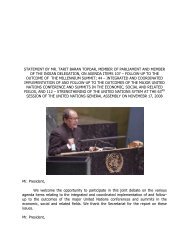STATE OF THE WORLD'S CITIES 2012/2013 Prosperity
STATE OF THE WORLD'S CITIES 2012/2013 Prosperity
STATE OF THE WORLD'S CITIES 2012/2013 Prosperity
You also want an ePaper? Increase the reach of your titles
YUMPU automatically turns print PDFs into web optimized ePapers that Google loves.
State of the World’s Cities <strong>2012</strong>/<strong>2013</strong><br />
FACT<br />
FACT<br />
Cities are best able to<br />
Asia and the Arab<br />
States appear to<br />
combine sustainability and<br />
best placed, in terms of<br />
shared prosperity through<br />
capacities, to deal with<br />
effective urban governance<br />
environmental concerns and transformational<br />
and bring about more<br />
leadership. This type of<br />
sustainable cities.<br />
leadership recognises<br />
the complex interactions<br />
between urbanisation and<br />
the environment at the local, regional, and global levels.<br />
The next step is to put in place appropriate institutions<br />
and build the institutional building capacities required<br />
for environmentally sustainable urban systems including<br />
transport, energy, waste management, rehabilitation of<br />
the built and natural environments, and management of<br />
ecosystem services.<br />
For the time being, local experts across all developing<br />
regions clearly highlight financial and institutional<br />
capacities as a major problem (Table 2.5.2). More<br />
specifically, only a few believe that efficient systems<br />
are in place in their respective regions to monitor<br />
environmental sustainability or the transport sector. Local<br />
experts also identify further challenges, suggesting that<br />
growth has a critical role to play if cities are to be in a<br />
Table 2.5.2<br />
Cities with the capacity for environmental sustainability*<br />
Region<br />
Environmental sustainability requires capacity-building<br />
and resource availability at the local level.<br />
Local authorities<br />
with financial<br />
& institutional<br />
capacity (%)<br />
Integration of<br />
environmental<br />
protection plans<br />
in to policies and<br />
strategies (%)<br />
86<br />
position to tackle the effects of climate change on top of<br />
poverty and inequity.<br />
The need for adequate capacity is further underscored by<br />
the fact that whereas environmental sustainability is widely<br />
recognised as essential, local authorities when faced with<br />
competing demands and budget constraints, consider it to<br />
be the least of priorities. 45 This has implications for cities,<br />
especially given the role they must play in local environmental<br />
issues, including when it comes to responding to the needs<br />
of the population at a time when the need for environmental<br />
preservation is gaining more recognition in public opinion. 46<br />
Efficient<br />
monitoring<br />
systems for<br />
environmental<br />
sustainability (%)<br />
Cities with<br />
environmental<br />
transport policies<br />
(%)<br />
Cities making<br />
progress<br />
toward more<br />
sustainable urban<br />
environment<br />
(%)<br />
Africa 22 48 17 9 36<br />
Arab States 60 46 37 8 46<br />
Asian 64 65 45 31 70<br />
Latin America & the Caribbean 24 47 21 8 46<br />
All Regions 39 51 28 36 43<br />
* As perceived by local experts surveyed by UN-Habitat<br />
Source: UN-Habitat, City Monitoring Branch, Policy Survey, 2011<br />
Kuwait City: skyscraper under construction.<br />
© <strong>2012</strong> Wael Hamdan/fotoLIBRA.com















![1 statement by dr.[mrs] kakoli ghosh dastidar - Member States Portal](https://img.yumpu.com/27526598/1/190x245/1-statement-by-drmrs-kakoli-ghosh-dastidar-member-states-portal.jpg?quality=85)

